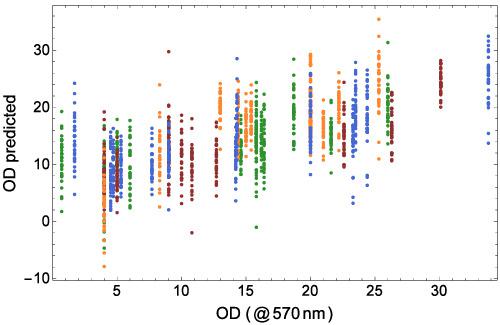当前位置:
X-MOL 学术
›
J. Raman Spectrosc.
›
论文详情
Our official English website, www.x-mol.net, welcomes your
feedback! (Note: you will need to create a separate account there.)
Correlation of crystal violet biofilm test results of Staphylococcus aureus clinical isolates with Raman spectroscopic read-out
Journal of Raman Spectroscopy ( IF 2.4 ) Pub Date : 2021-08-30 , DOI: 10.1002/jrs.6237 Christina Ebert 1, 2 , Lorena Tuchscherr 2, 3 , Nancy Unger 1, 2 , Christine Pöllath 2, 3 , Frederike Gladigau 1, 4 , Jürgen Popp 1, 2, 4 , Bettina Löffler 2, 3 , Ute Neugebauer 1, 2, 4
Journal of Raman Spectroscopy ( IF 2.4 ) Pub Date : 2021-08-30 , DOI: 10.1002/jrs.6237 Christina Ebert 1, 2 , Lorena Tuchscherr 2, 3 , Nancy Unger 1, 2 , Christine Pöllath 2, 3 , Frederike Gladigau 1, 4 , Jürgen Popp 1, 2, 4 , Bettina Löffler 2, 3 , Ute Neugebauer 1, 2, 4
Affiliation

|
Biofilm-related infections occur quite frequently in hospital settings and require rapid diagnostic identification as they are recalcitrant to antibiotic therapy and make special treatment necessary. One of the standard microbiological in vitro tests is the crystal violet test. It indirectly determines the amount of biofilm by measuring the optical density (OD) of the crystal violet-stained biofilm matrix and cells. However, this test is quite time-consuming, as it requires bacterial cultivation up to several days. In this study, we correlate fast Raman spectroscopic read-out of clinical Staphylococcus aureus isolates from 47 patients with different disease background with their biofilm-forming characteristics. Included were low (OD < 10), medium (OD ≥ 10 and ≤20), and high (OD > 20) biofilm performers as determined by the crystal violet test. Raman spectroscopic analysis of the bacteria revealed most spectral differences between high and low biofilm performers in the fingerprint region between 750 and 1150 cm−1. Using partial least square regression (PLSR) analysis on the Raman spectra involving the three categories of biofilm formation, it was possible to obtain a slight linear correlation of the Raman spectra with the biofilm OD values. The PLSR loading coefficient highlighted spectral differences between high and low biofilm performers for Raman bands that represent nucleic acids, carbohydrates, and proteins. Our results point to a possible application of Raman spectroscopy as a fast prediction tool for biofilm formation of bacterial strains directly after isolation from the infected patient. This could help clinicians make timely and adapted therapeutic decision in future.
中文翻译:

金黄色葡萄球菌临床分离株结晶紫生物膜检测结果与拉曼光谱读数的相关性
生物膜相关感染在医院环境中经常发生,需要快速诊断识别,因为它们对抗生素治疗有抵抗力,因此需要特殊治疗。标准微生物体外试验之一是结晶紫试验。它通过测量结晶紫染色的生物膜基质和细胞的光密度 (OD) 来间接确定生物膜的数量。然而,这项测试非常耗时,因为它需要细菌培养长达数天。在这项研究中,我们关联了临床金黄色葡萄球菌的快速拉曼光谱读数从 47 名具有不同疾病背景的患者中分离出具有生物膜形成特征的菌株。包括通过结晶紫测试确定的低 (OD < 10)、中 (OD ≥ 10 和 ≤ 20) 和高 (OD > 20) 生物膜执行者。细菌的拉曼光谱分析揭示了 750 和 1150 cm -1之间指纹区域中高生物膜表现者和低生物膜表现者之间的大部分光谱差异. 对涉及三类生物膜形成的拉曼光谱使用偏最小二乘回归 (PLSR) 分析,可以获得拉曼光谱与生物膜 OD 值的轻微线性相关性。PLSR 加载系数突出了代表核酸、碳水化合物和蛋白质的拉曼谱带的高生物膜性能和低生物膜性能之间的光谱差异。我们的结果表明拉曼光谱作为一种快速预测工具的可能应用,用于在从受感染的患者中分离后直接用于细菌菌株的生物膜形成。这可以帮助临床医生在未来做出及时和适应的治疗决策。
更新日期:2021-08-30
中文翻译:

金黄色葡萄球菌临床分离株结晶紫生物膜检测结果与拉曼光谱读数的相关性
生物膜相关感染在医院环境中经常发生,需要快速诊断识别,因为它们对抗生素治疗有抵抗力,因此需要特殊治疗。标准微生物体外试验之一是结晶紫试验。它通过测量结晶紫染色的生物膜基质和细胞的光密度 (OD) 来间接确定生物膜的数量。然而,这项测试非常耗时,因为它需要细菌培养长达数天。在这项研究中,我们关联了临床金黄色葡萄球菌的快速拉曼光谱读数从 47 名具有不同疾病背景的患者中分离出具有生物膜形成特征的菌株。包括通过结晶紫测试确定的低 (OD < 10)、中 (OD ≥ 10 和 ≤ 20) 和高 (OD > 20) 生物膜执行者。细菌的拉曼光谱分析揭示了 750 和 1150 cm -1之间指纹区域中高生物膜表现者和低生物膜表现者之间的大部分光谱差异. 对涉及三类生物膜形成的拉曼光谱使用偏最小二乘回归 (PLSR) 分析,可以获得拉曼光谱与生物膜 OD 值的轻微线性相关性。PLSR 加载系数突出了代表核酸、碳水化合物和蛋白质的拉曼谱带的高生物膜性能和低生物膜性能之间的光谱差异。我们的结果表明拉曼光谱作为一种快速预测工具的可能应用,用于在从受感染的患者中分离后直接用于细菌菌株的生物膜形成。这可以帮助临床医生在未来做出及时和适应的治疗决策。











































 京公网安备 11010802027423号
京公网安备 11010802027423号